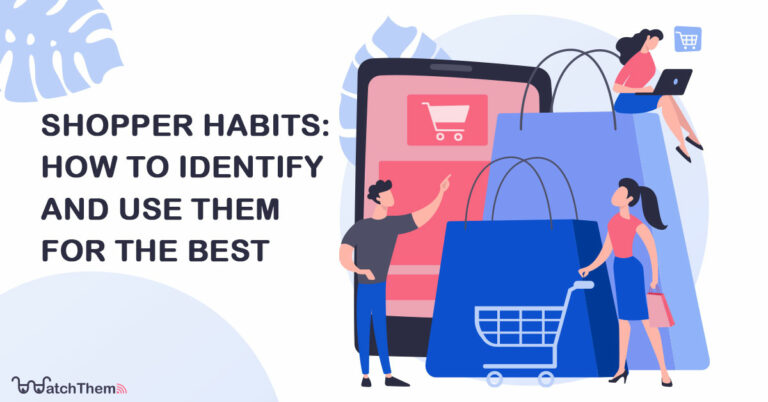Page Contents
Let’s have a look at our daily decisions. What should I eat today? What should I wear for work? Which perfume should I use? And so on. If we look closer at these questions we understand that we don’t think much about making many of our daily decisions. This is exactly true in the shopping matter. We all have shopper habits and customer behaviors that are identical to ourselves.
Let’s open it up a little. When you go to a supermarket to buy some groceries, there are many factors that make you buy a specific brand even without thinking about it. You go straight for that brand and supermarket every time. This is what we call shopper habits and we are going to see what they are and how we can benefit from them.
Marketing Strategies article that you should read


What Does Shopper Habits Mean?
Shopper Habits are the tendencies that customers have when they are shopping and purchasing some product. For learning about these habits we should study them and understand why exactly each customer does certain things during his/her buying process.
As we mentioned before, there are several factors working together here such as physical, mental, and emotional factors. We should consider studying each one separately and together to feel the impact of each one on customers’ shopping behaviors.
Why is Learning Shopper Habits Important?
Imagine spending lots of money on your marketing campaigns and advertisements without knowing exactly what your customers want and prefer. Is it going to raise your conversion rate? Or does it provide more revenue for the company? Maybe at some rate but you should know that with less money spent you could get more value.
Studying shopper habits will help marketers to see what their customers lean for in the market. It can fill the market gap and acquire some percentage of the market. For this purpose, you need to analyze customers’ behaviors. It must answer these questions to be beneficial:
- What consumers think and how they feel about various alternatives (brands, products, etc.);
- What influences consumers to choose between various options;
- Consumers’ behavior while researching and shopping;
- How consumers’ environment (friends, family, media, etc.) influences their behavior.
We also can use information that we get from our buyer’s journey map. So, we get to see where our customers are and what their preferences are.


What Influences Shopper Habits?
Now we know about the importance of our customers’ habits. Let’s talk about what will influence those habits and in which way.
Two types of influences significantly affect the customers’ buying habits, internal and external:
1. Internal influences
Internal influences are the factors that affect customer purchases that come from the customers themselves. For example, the customer wants, needs, desires, and preferences are internal influences that drive purchasing decisions. Also, hunger, health reasons, boredom, or a desire to travel are all internal influences.
Some of these may be obvious but some like psychological factors such as mood, social status, or time of day aren’t that clear to distinguish.
2. External influences
External influences are the things that influence shopper habits outside of individual wants and needs. Billboards, Facebook ads, celebrities, customer testimonials, and current trends are all external factors that influence customer buying decisions.
Branding and marketing campaigns are external tools. Using these external factors can be very beneficial and drive customers toward your products.
When do Customers’ Shopper Habits Occur?
It’s not like this that all of the customers’ shoppings are influenced by their habits. We can categorize shopping behaviors into four major groups:
1. Complex Buying Behaviors
This happens when the customer is heavily participating in the shopping process. It usually occurs when they are buying something expensive. Or, they don’t have any experience in that area such as buying a car or a house.
2. Dissonance-reducing Buying Behavior
The consumer is highly involved in the purchase process but has difficulties determining the differences between brands. ‘Dissonance’ can occur when the consumer worries that they will regret their choice. For example, you buy some product and after that, you will start to check other similar product’s price or quality.
3. Habitual buying behavior
This is where the shopper habits take in and control the purchase process. This occurs when the customer has little effort on his/her purchase. Just like grocery shopping that we mentioned before, there is not much loyalty or thinking in that.
4. Variety seeking behavior
In this situation, a consumer purchases a different product not because they weren’t satisfied with the previous one. On the contrary, it’s because they seek variety. Like when you are trying out new shower gel scents.


How to Track Shopper Habits?
Now that you know what can influence customer behavior, you may need some help in tracking these various factors. Website analytics can help you track customer search queries—the searches people use that bring them to your website. Knowing what brought someone to your business’s website puts you into the mindset of the customer and can give you valuable insight into the influences that drive sales.
One of these tools that can help you in this matter is the WatchThemLive analytics tool. It will gather all the information you need to work around them and use your customers’ habits to your advantage. If you need more information about our other services you can simply find it here.
Another way to track customer buying habits is through the use of loyalty programs. Loyalty programs offer an incentive to get return customers. They can show sales patterns and help you build a rapport with customers and get to know them better. The better you know your customers, the more effectively you can sell to them.
Conclusion
Now we have hopefully demystified what shopper habits are and how you can identify and leverage them to reach more of the right customers. You can use this information to hone in on your target audience, which should produce good results. This will give your company the competitive advantage that needs in your market area.

